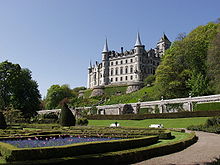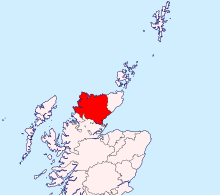Sutherland

Sutherland (also Sutherlandshire , Gaelic Cataibh ) is a traditional county in the Highlands of Scotland , bordering the counties of Caithness , Ross-shire and Cromartyshire . The title Duke of Sutherland is derived from the county.
Origin of the name for the region
The name Sutherland is derived from the rule of the Norwegian Vikings over the settlements in the Scottish highlands and the northern and western islands. From their northern, orcadian point of view, the north-west corner of the main island was the “ Suðrland ” ( Old Norse ) for southern land . The Vikings also referred to the Hebrides as Suðreyjar (southern islands) with reference to the "northern islands" ( Orkney , Shetland , Faroe Islands ). In Gaelic this area traditionally has two names: in the northwest it was referred to as Dùthaich MhicAoidh (or Dùthaich 'IcAoidh ); in the southeast as Cataibh . The term Cataibh is also sometimes used for the entire region, hence the term Caithness in English. The Scottish Gaelic name for Caithness , however, is Gallaibh , which means "among strangers" because of the strong Nordic settlement. The north-westernmost corner of Sutherland, traditionally known as the "Province of Strathnaver", was only converted to Sutherland in 1601. It was the home of the powerful and warlike Mackay clan , hence the name Dùthaich 'Ic Aoidh (home of the Mackay). This region is still called "Mackay Country" in Sutherland today.
Geographical location
With an area of 5252 km², Sutherland only has around 13,000 inhabitants (around 2.5 inh / km²) and is therefore one of the most sparsely populated regions in Europe. This is due, among other things, to the Highland Clearances in the 19th century, during which large parts of the local population were expelled to make room for large-scale sheep farming. Memorial sites in memory of the displaced have been set up at various locations in Sutherland; the best known is a monument in Bettyhill . There is no city in the entire county.
The county includes the towns of Dornoch (county seat), Brora , Durness , Tongue , Golspie , Helmsdale , Lochinver and Kinlochbervie . In 1975 Sutherland became a District of the Highland Region , which was converted into the Highland Council Area in 1996 . Sutherland is still one of the Lieutenancy Areas of Scotland today .
Similar to Caithness Sutherland is rich in natural monuments such as the Cracknie basement , but especially in cairns as the Cairn of Skail and Broch and the Broch of Feranach or Broch of Sallachy . They are clearly visible in prominent places near the coast and on rivers, on ridges or low hills. They appear to have been used for a very long period.
The area has three coasts - the northern and the western and, apart from that, the eastern. There are high cliffs and sandy beaches here. In the hinterland you can find treeless mountains and moorlands.
Sutherland in culture
The archaeological sites of Sutherland are mainly concentrated along the coasts and on both sides of the inland river valleys.
In MC Beaton's "Hamish Macbeth Mystery" series, the fictional cities of Lochdubh and Strathbane are in Sutherland. Rosamunde Pilcher's last novel, Winter solstice, takes place in the area around the fictional town of Creagan, which represents the village of Dornoch.
literature
- Robert Gourlay: Sutherland - a historical guide. Birlinn, Edinburgh 1996, ISBN 1-874744-44-0 .
Web links
Individual evidence
- ↑ Discover Sutherland. discoversutherland.co.uk, 2007, accessed June 24, 2013 .
- ↑ Sutherland. (No longer available online.) Gross britain.de, archived from the original on January 7, 2015 ; Retrieved June 24, 2013 . Info: The archive link was inserted automatically and has not yet been checked. Please check the original and archive link according to the instructions and then remove this notice.
